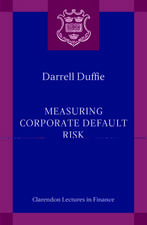Capital Structure in the Modern World
Autor Anton Migloen Limba Engleză Paperback – 31 mai 2018
| Toate formatele și edițiile | Preț | Express |
|---|---|---|
| Paperback (1) | 887.05 lei 6-8 săpt. | |
| Springer International Publishing – 31 mai 2018 | 887.05 lei 6-8 săpt. | |
| Hardback (1) | 892.28 lei 6-8 săpt. | |
| Springer International Publishing – 15 iul 2016 | 892.28 lei 6-8 săpt. |
Preț: 887.05 lei
Preț vechi: 1081.77 lei
-18% Nou
Puncte Express: 1331
Preț estimativ în valută:
169.78€ • 174.97$ • 143.34£
169.78€ • 174.97$ • 143.34£
Carte tipărită la comandă
Livrare economică 03-17 martie
Preluare comenzi: 021 569.72.76
Specificații
ISBN-13: 9783319808734
ISBN-10: 3319808737
Ilustrații: XX, 254 p. 36 illus.
Dimensiuni: 148 x 210 mm
Greutate: 0.33 kg
Ediția:Softcover reprint of the original 1st ed. 2016
Editura: Springer International Publishing
Colecția Palgrave Macmillan
Locul publicării:Cham, Switzerland
ISBN-10: 3319808737
Ilustrații: XX, 254 p. 36 illus.
Dimensiuni: 148 x 210 mm
Greutate: 0.33 kg
Ediția:Softcover reprint of the original 1st ed. 2016
Editura: Springer International Publishing
Colecția Palgrave Macmillan
Locul publicării:Cham, Switzerland
Cuprins
Chapter 1) Introduction.- Section I.- Chapter 2) Modigliani-Miller Proposition and Trade-Off Theory.- Chapter 3) Asymmetric Information and Capital Structure.- Chapter 4) Credit Rationing and Asset Substitution.- Chapter 5) Debt Overhang.- Section II.- Chapter 6) Capital Structure Choice and Firm’s “Quality”.- Chapter 7) Capital Structure and Corporate Governance.- Chapter 8) Capital Structure of Start-Up Firms and Small Firms.- Chapter 9) Corporate Capital Structure vs. Project Financing.- Chapter 10) Capital Structure Analysis: Some Examples.
Recenzii
“The book is aimed to review the main theoretical concepts of capital structure and to cast attention on some still growing areas of research. … the book has the noteworthy merit of keeping a balance between theory and practice of firm’s financing choices, providing a useful overview for the interested reader of the modern state of capital structure theory.” (Anna Maria C. Menichini, Journal of Economics, Vol. 122, 2017)
Notă biografică
Professor Anton Miglo is Associate Professor of Finance at the School of Business at Nipissing University, Canada. He obtained his Candidate of Science Degree from Saint-Petersburg State University in 1998 and PhD with excellence in economics (concentration in finance) from the University of Quebec in Montreal (Canada) in 2005. During his studies, Professor Miglo was awarded prestigious scholarships from the Canadian Council of Social Science Research and Montreal Institute of Financial Mathematics. Over the course of his career, Professor Miglo has taught numerous finance courses including Theory of Finance, Financial Management, Entrepreneurial Finance, Advanced Topics in Finance, Investments, Finance with Excel and Financing Strategies and Corporate Governance. He is the author of numerous academic publications. Professor Miglo areas of expertise include capital structure and financial contracts.
Textul de pe ultima copertă
This book focuses on microeconomic foundations of capital structure theory. It combines theoretical results with a large number of examples, exercises and applications. The book examines fundamental ideas in capital structure management, some of which are still not very well understood in the business community, such as Modigliani and Miller’s irrelevance result, trade-off theory, pecking-order theory, asset substitution, credit rationing and debt overhang. Chapters also cover capital structure issues that have become very important following the recent financial crisis. Miglo discusses the ways in which financial economists were forced to look critically at capital structure, as the problems faced by many companies stemmed from their financing policies following the crisis. The book also discusses links between capital structure and firm’s performance, corporate governance, firm’s strategy and flexibility, and covers such topics as life cycle approach to capital structure management, capital structure of small and start-up companies, corporate financing versus project financing and examples of optimal capital structure analyses for different companies. This comprehensive guide to capital structure theory will be of interest to all students, academics and practitioners seeking to understand this fast-developing and critical area of business management.
Caracteristici
Focuses exclusively on capital structure management and financing decisions Covers both fundamentals and critical issues in capital structure management Written from a post financial crisis perspective Covers asymmetric information between investors and issuers Covers financing of small companies such as entrepreneurial finance, start-up funding, and crowdfunding Combines theoretical results with a large number of examples, exercises and applications












